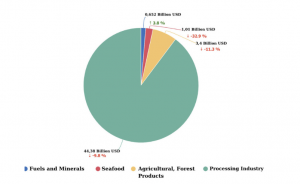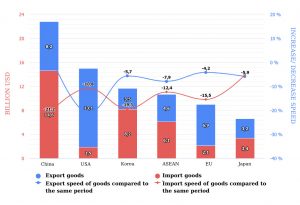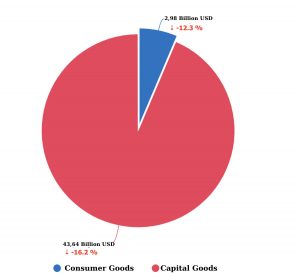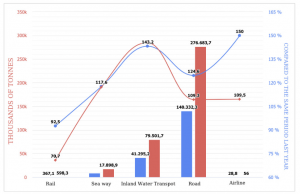Vietnam - Economic overview in February 2023
The average import-export turnover in the first 2 months of the year was about 48 billion USD, much lower than the average of nearly 61 billion USD in 2022. However, freight services were not affected.
According to preliminary data from the General Department of Customs, in February, Vietnam’s total import and export turnover reached 49.3 billion USD, of which exports reached 26.05 billion USD and imports reached 23.25 billion USD.

Growth rate of Exports in February 2023
Processed industrial goods accounted for a high proportion of export turnover accounting for 89.8%, down 9.8% over the same period last year. Ranked second is agricultural and forestry products accounting for 6.9%, down 11.3% over the same period last year. Next, seafood accounted for 2.0%, down 32.9% over the same period last year. And finally, fuels and minerals accounted for 1.3%, up 3.8% over the same period last year. Although it accounts for the lowest proportion of export turnover, it is also the only commodity that increases in export turnover.

Comparison table of Vietnam’s export and import growth rate in the first 2 months of the year compared to the same period last year.
The trade balance between Vietnam and significant regions has witnessed notable changes, with exports to China being the only standout as they rose by 4.2% compared to the previous year. However, all other figures indicate a decrease, exemplified by Vietnam’s declining export values to the US, Japan, South Korea, ASEAN, and the EU by 21%, 5.9%, 5.7%, 7.9%, and 4.2%, respectively. Additionally, imports into Vietnam also declined as imports from China fell by 21.2%, those from the US decreased by 10%, and those from South Korea and Japan dropped by 19.3% and 5.2%, respectively. Moreover, imports from ASEAN and the EU have also suffered, declining by 12.4% and 15.5%, respectively. These figures point to a significant shift in the economic landscape of Vietnam and its trading partners, highlighting the potential impact on businesses and industries across the region.

Growth rate of Imports in February 2023
Imports of production materials accounted for 93.6%, down 16.2% over the same period last year. And consumer goods accounted for 6.4% of import turnover, down 12.3% over the same period last year.

Growth rate of Freight Transport compared to the same period last year and February, 2023.
Freight transport was estimated at 374.7% million tons of transported goods, up 15.7% over the same period last year and 76 billion tons-km, up 20.3%. Specifically, a representative of the Ministry of Transport said that air cargo transport led in the growth rate with an increase of 50%, roads increased by 24.6%, waterways increased by more than 43%, seaways increased by 17.6%. Particularly, rail freight transport decreased by 7.5%.
Accumulated in the first 2 months of the year, the trade balance had a surplus of 3.44 billion USD, in contrast to the deficit of 300 million USD of the same period last year.
Source: VNeconomy